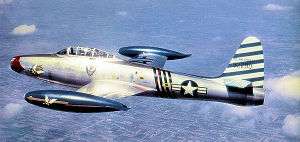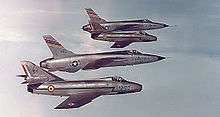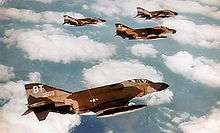36th Wing
| 36th Wing | |
|---|---|
|
36th Wing Insignia | |
| Active | 1 February 1940 |
| Country | United States |
| Branch | United States Air Force |
| Type | Combat support |
| Part of | Pacific Air Forces |
| Garrison/HQ | Andersen Air Force Base |
| Nickname(s) | The Fightin’ 36th |
| Motto | “Prepared to Prevail” |
| Decorations |
Belgium Fourragère |
| Commanders | |
| Current commander | Brigadier General Andrew J. Toth |
| Notable commanders | Ronald Keys |

_of_6_Sqn_arrives_at_Andersen_Air_Force_Base%2C_-30_Jan._2009_a.jpg)
The United States Air Force's 36th Wing is the host wing for Andersen Air Force Base, Guam. It is part of United States Pacific Air Forces Eleventh Air Force. The 36th Wing provides day-to-day mission support to more than 9,000 military, civilian, dependent and retired personnel and 15 associate units on the base.
Mission
The 36th Wing's and Andersen Air Force Base's official mission statement is "...to employ, deploy, integrate and enable air and space forces from the most forward US sovereign Air Force Base in the Pacific."
More simply, the 36th Wing has three major missions: Operate Andersen AFB via its subordinate 36th Mission Support and 36th Medical Groups; Provide power projection through an attached, rotational bomber force via its subordinate 36th Operations and 36th Maintenance Groups; and provide rapid air base opening and initial air base operation ability via its subordinate 36th Contingency Response Group.
Assisting the 36th Wing in accomplishing this mission is the 734th Air Mobility Squadron, which operates Andersen's air cargo terminal on behalf of Air Mobility Command.
Units
- 36th Operations Group
- 36th Maintenance Group
- 36th Expeditionary Aircraft Maintenance Squadron
- 36th Maintenance Squadron
- 36th Munitions Squadron
- 36th Contingency Response Group
- 736th Security Forces Squadron
- 36th Mobility Response Squadron
- 644th Combat Communications Squadron
- 36th Medical Group
- 36th Medical Operations Squadron
- 36th Medical Support Squadron
- 36th Mission Support Group
- 36th Communications Squadron
- 36th Civil Engineering Squadron
- 36th Contracting Squadron
- 36th Logistics Readiness Squadron
- 36th Security Forces Squadron
- 36th Force Support Squadron
History
- For additional history and lineage, see 36th Operations Group
On 2 July 1948 the United States Air Force 36th Fighter Wing was activated at Howard Air Force Base. The former USAAF 36th Fighter Group became the operational component of the new Air Force wing. Active squadrons of the 36th were:
- 22d Fighter Squadron (F-80A/B, Red color band)
- 23d Fighter Squadron (F-80A/B, Blue color band)
- 53d Fighter Squadron (F-80A/B, Green color band)
United States Air Forces in Europe





As a result of the Berlin Blockade and other Cold War tensions in Europe, the 36th Fighter Wing was reassigned to USAFE. The squadron was assigned to Fürstenfeldbruck Air Base West Germany on 13 August 1948, being the first USAFE unit to be jet-equipped with the Lockheed F-80 "Shooting Star". At Fürstenfeldbruck tactical operations included air defense, tactical exercises, maneuvers, and photographic reconnaissance. In May 1949, the wing formed the Skyblazers aerial demonstration team, which it controlled until August 1952, and again from October 1956 to January 1962 when it was disbanded.
On 20 January 1950, the wing was redesignated as the 36th Fighter-Bomber Wing (FBW) when 89 Republic F-84E "Thunderjets" arrived. Existing USAFE bases in West Germany, however, were deemed very vulnerable to an attack by the Soviet Union, given their proximity to East Germany and other Warsaw Pact nations. Negotiations with other NATO nations were made to build new bases west of the Rhine River. The F-80s were sent back to CONUS to equip Air National Guard units. In addition to its primary installation at Fürstenfeldbruck, the wing controlled Oberpfaffenhofen AB, West Germany, December 1949 – February 1950.
The 36th FBW remained at Fürstenfeldbruck until 1952 when it was reassigned to the new Bitburg Air Base, in the Eifel mountains west of the Rhine River. Throughout the summer, elements of the 36th FBW moved into Bitburg, with the wing officially arriving in November 1952. Under various designations, the 36th would remain at Bitburg for the next 40 years.
In August 1953, the North American F-86F "Sabre" was introduced to the wing, replacing the F-84s. On 31 March 1954, The 1st Pilotless Bomber Squadron, equipped with the B-61A Matador, was assigned to the 36th Fighter Bomber Wing, Bitburg Air Base, Germany, making it the first operational U.S. missile unit. The 1st PBS eventually was renamed to Tactical Missile Squadron (TMS), and in 1958 was renumbered to the 71st TMS and the unit was assigned to the 701st TMW at Hahn, although stationed at Bitburg Air Base.
In August 1954, the wing was redesignated as the 36th Fighter-Day Wing.
In 1956, the wing received the North American F-100 "Super Sabre," marking the first time a wing in USAFE flew supersonic jets. On 15 May 1958, the 36th FDW was redesignated as the 36th Tactical Fighter Wing (TFW), with its squadrons redesignated as Tactical Fighter Squadrons, because its missions had now grown to include delivery of tactical nuclear weapons.
In May 1961, the wing received the Republic F-105 "Thunderchief". Formal USAFE acceptance of the Mach 2 fighter-bombers was held at the Paris Air Show on 3 June 1961. Deliveries of the F-105D model were completed in 1963, and the 36th carried on its Cold War mission of tactical nuclear weapons delivery. Twice in the early 1960s when Cold War tensions were elevated due to the 1961 Berlin Wall crisis and 1962 Cuban Missile Crisis the 36th TFW rose to a high level of alert.
By 1966 the Thud was being phased out of NATO, being replaced by the McDonnell F-4D "Phantom II". The tactical nuclear deliver mission, still necessary, was being eclipsed by the ability of ICBMs and the primary mission of the 36th TFW changed to Tactical Air support of NATO ground units in West Germany. By December 1966, all the 36th TFW Thuds had been ferried Stateside for combat crew training duties at McConnell AFB, Kansas, or on to warfighting glory in Southeast Asia after stateside refurbishment.
In October 1965, the 36th TFW accepted command of the 71st Tactical Missile Squadron from the inactivated 38th Tactical Missile Wing at Sembach Air Base. (36th TFW Special Order AA-84, 29 September 1965). The 36th TFW maintained and operated two hardened launch sites (at Rittersdorf, Site 7, and at Idenheim, site 8) with a total of 16 VA CGM-13B Mace tactical missiles until 30 April 1969.
In September 1969, the 36th TFW took responsibility for Spangdahlem Air Base West Germany until December 1971.
By 1976 a major modernization of USAFE was necessary. The Soviet Union's new generation of MiG and Sukhoi fighters made NATO military planners anxious. Indeed, intelligence reports about the MiG-25 left little room for comfort; the performance of this latest Russian combat aircraft was far superior to any NATO aircraft. The twin-engined MiG-25 reached speeds of over 3,000 km/h even at high altitude (over 70,000 feet) and it could be armed with radar-guided AA-6 Acrid air-to-air missiles. When the Soviets stationed large numbers in the Soviet Union and later in the GDR, NATO had to address this problem.
The solution was provided by the McDonnell Douglas F-15 Eagle. Just like the MiG-25 it has two powerful engines and a double tail fin. The 23 aircraft for the first operational squadron (525 TFS) with the 36th TFW left Langley AFB on 27 April 1977 for a mass Atlantic crossing. Over the following months the aircraft for two other squadrons (22nd TFS and 53rd TFS) arrived. The 36th TFW's full strength of 79 fully operational F-15As was reached in December 1977. In 1980 more advanced F-15Cs and F-15Ds would replace the original F-15As.
Throughout the 1970s and 1980s, the 36th TFW conducted routine training missions however the outbreak of the 1990–91 Gulf War put the F-15s of Bitburg into the heart of the conflict. The 36th TFW's pilots and aircraft performed magnificently in Operation Desert Storm. Not a single F-15 aircraft was lost in combat during the war. On 13 March 1991, the deployed squadrons of the 36th TFW returned in victory.
The celebration was brief, however, as the 36th TFW deployed back Incirlik Air Base, Turkey to support Operation PROVIDE COMFORT. Between 5 April and 25 May 1991, the 36th TFW flew 285 sorties over Iraq. Just as before, not a single aircraft was lost in Iraq due to hostile fire.
On 1 October 1991 the wing was redesignated as the 36th Fighter Wing when the objective wing concept was implemented.
The 525th Fighter Squadron was inactivated 31 March 1992 as part of the initial post Cold-War drawdown.
Bitburg Air Base was part of the 1993 Base Realignment and Closure (or BRAC) process that saw the drawdown of many military facilities in a series of post-Cold War force reductions. In July 1993, HQ USAFE announced the closure of Bitburg Air Base and the pending inactivation of the 36th Fighter Wing.
- The 53d Fighter Squadron was inactivated 1 February 1994. It was transferred without personnel or equipment to the 52d Operations Group (52d FW) at Spangdahlem Air Base.
Note: Some aircraft transferred to 22d Fighter Squadron and 53d FS inactivated 31 March 1999 as part of Air Force-wide reorganization to enlarge F-15 squadrons from 18 to 24 aircraft. - The 22d Fighter Squadron was inactivated 31 March 1994. It was transferred without personnel or equipment to the 52d Operations Group (52d FW) at Spangdahlem Air Base.
On 1 October 1994 the 36th Fighter Wing was inactivated and the final 36th Wing Commander, Brigadier General Roger E. Carleton, presented Bitburg Air Base to the German government.
Pacific Air Forces
The Wing was reactivated without personnel or equipment at Andersen AFB, Guam the same day as the 36th Air Base Wing, a non-flying organization taking over as the host unit. The former host unit, 633d Air Base Wing was inactivated in keeping with the Air Force Chief of Staff's policy of keeping the most highly decorated and longest serving Air Force units on active duty.
The wing's combat readiness was tested between December and March 1991 during a deployment to Southwest Asia as part of Operations Desert Shield, Desert Storm and Proven Force. While flying combat air patrols during the war, the F-15s of the 36th were a strong deterrent to the air forces of Iraq. During Operation Desert Storm, the 36th was credited with downing 17 enemy aircraft in air-combat engagements. On 1 October 1991, the 36th Tactical Fighter Wing was redesignated the 36th Fighter Wing, and in July 1994, the 36th Fighter Wing was inactivated.
The 36th Air Base Wing was activated at Andersen Air Force Base, Guam, on 30 September 1994. Under that designation, the wing lived up to its mission several times. In September 1996, the wing provided around-the-clock forward-deployment support to Air Combat Command B-52s during their Operation Desert Strike missions over Iraq, and began hosting more than 6,600 Kurdish evacuees during the 8-month humanitarian assistance mission, Joint Task Force Pacific Haven.
On 12 April 2006, Andersen AFB's host unit, the 36th Air Base Wing was officially redesignated as the 36th Wing. Prior to the redesignation, the wing had been using a temporary designation of air expeditionary wing. The change in the wing's official designation was meant to better align Andersen with its mission statement: "To provide a U.S.-based lethal warfighting platform for the employment, deployment, reception, and throughput of air and space forces in the Asia-Pacific region."
In February 2007, the 36th Operations Group was reactivated as a permanent subordinate unit to the 36th Wing, replacing the temporary 36th Expeditionary Operations Group.
Lineage
- Established as 36th Fighter Wing on 17 June 1948
- Activated on 2 July 1948
- Redesignated: 36th Fighter-Bomber Wing on 20 January 1950
- Redesignated: 36th Fighter-Day Wing on 9 August 1954
- Redesignated: 36th Tactical Fighter Wing on 8 July 1958
- Redesignated: 36th Fighter Wing on 1 October 1991
- Inactivated on 1 October 1994
- Redesignated: 36th Air Base Wing, and activated, on 1 October 1994
- Redesignated 36th Wing on 15 March 2006.
Assignments
|
|
Components
Wings
- 121st Tactical Fighter Wing: attached 12–27 May 1977
- 7149th Tactical Fighter Wing: attached 15 April – 15 September 1969
Group
- 36th Fighter (later 36th Operations) Group: 2 July 1948 – 8 December 1957 (not operational, 1 October 1956 – 8 December 1957), 31 March 1992 – 1 October 1994; 15 March 2006 – present
Squadrons
- 7th Tactical Fighter Squadron: attached 2 March – 4 April 1973; attached 3 April – 3 May 1974; attached 4 October – 6 November 1975
- 9th Tactical Fighter Squadron: attached 12 September – 6 October 1970; attached 4 February – 15 March 1973; attached 6 September – 7 October 1975.
- 18th Tactical Reconnaissance Squadron: attached 12–28 April 1977.
- 22d Pursuit (later, 22d Fighter; 22d Fighter-Bomber; 22d Fighter-Day; 22d Tactical Fighter) Squadron, 1 February 1940 – 31 March 1946; 15 October 1946 – 8 December 1957; attached 1 October 1956 – 7 December 1957, assigned 8 December 1957 – (not operational, 25 October 1976 – 30 June 1977); 31 March 1992 – 1 April 1994
- 23 Pursuit (later, 23d Fighter; 23d Fighter-Bomber; 23d Fighter-Day, 23d Tactical Fighter) Squadron, 1 February 1940 – 31 March 1946; 15 October 1946 – 8 December 1957; attached 1 October 1956 – 7 December 1957, assigned 8 December 1957 – 31 December 1971
- 32d Pursuit (later, 32d Fighter) Squadron, 1 February 1940 – 3 August 1943; 8 September 1955 – 8 December 1957; attached 1 October 1956 – 7 December 1957, assigned 8 December 1957 – 8 April 1960
- 53d Fighter (later, 53d Fighter-Bomber; 53d Fighter) Squadron, 23 June 1943 – 31 March 1946; 15 October 1946 – 8 December 1957; attached 1 October 1956 – 7 December 1957, assigned 8 December 1957 – (not operational, 1 February – July 1977); 31 March 1992 – 25 February 1994.
- 461st Tactical Fighter Squadron: attached 1 October 1956 – 7 December 1957, assigned 8 December 1957 – 1 August 1959
- 525th Tactical Fighter Squadron: 1 November 1968 – (not operational, 9 March – 26 April 1977).
- 39th Tactical Reconnaissance Training Squadron: attached 1 April 1969 – 31 December 1971
- 45th Tactical Reconnaissance Squadron: attached 13 August 1948 – 25 March 1949
- 1st Pilotless Bomber (later, 1st Tactical Missile) Squadron: attached 14 March 1955 – 15 April 1956.
- 71st Tactical Missile Squadron: 1 October 1965 – 30 April 1969
Stations
- Howard Field, Canal Zone, 2–25 July 1948
- Furstenfeldbruck AB, Germany (later West Germany), 13 August 1948
- Bitburg AB, West Germany (later Germany), 17 November 1952 – 1 October 1994
- Andersen AFB, Guam, 1 October 1994 – present
References
![]() This article incorporates public domain material from websites or documents of the Air Force Historical Research Agency.
This article incorporates public domain material from websites or documents of the Air Force Historical Research Agency.
- Air Force Historical Research Agency, 36 Wing
- Endicott, Judy G., USAF Active Flying, Space, and Missile Squadrons as of 1 October 1995. Office of Air Force History
- Martin, Patrick, Tail Code: The Complete History Of USAF Tactical Aircraft Tail Code Markings, 1994
- Rogers, Brian, United States Air Force Unit Designations Since 1978, 2005
- USAAS-USAAC-USAAF-USAF Aircraft Serial Numbers—1908 to Present
- Mindling, George, and Bolton, Robert, U.S. Air Force Tactical Missiles 1949–1969 The Pioneers 2008
External links
| |||||||||||||||||||||||||||||||||||||||||||||||
| ||||||||||||||||
| |||||||||||||||||||||||||||



